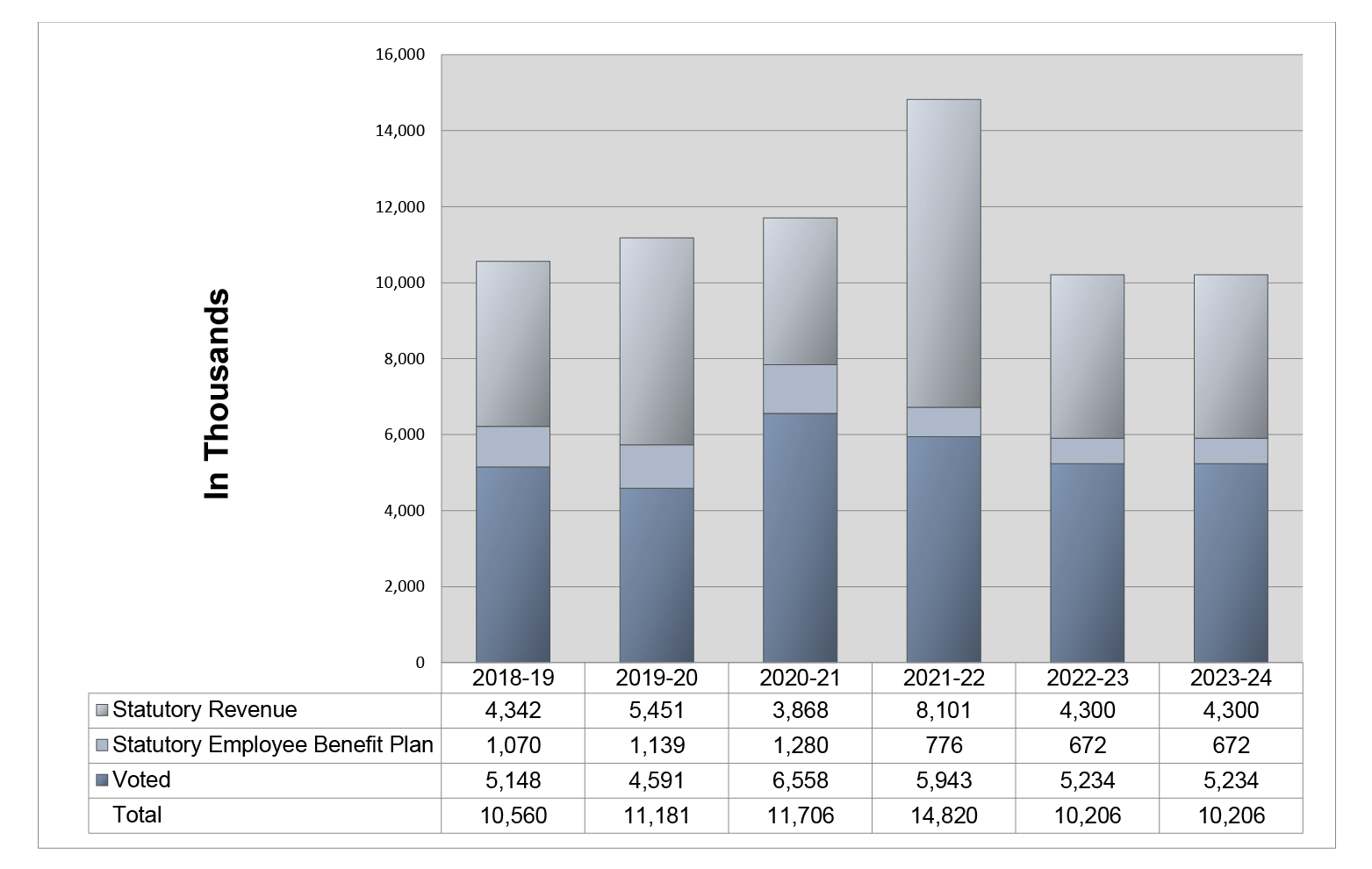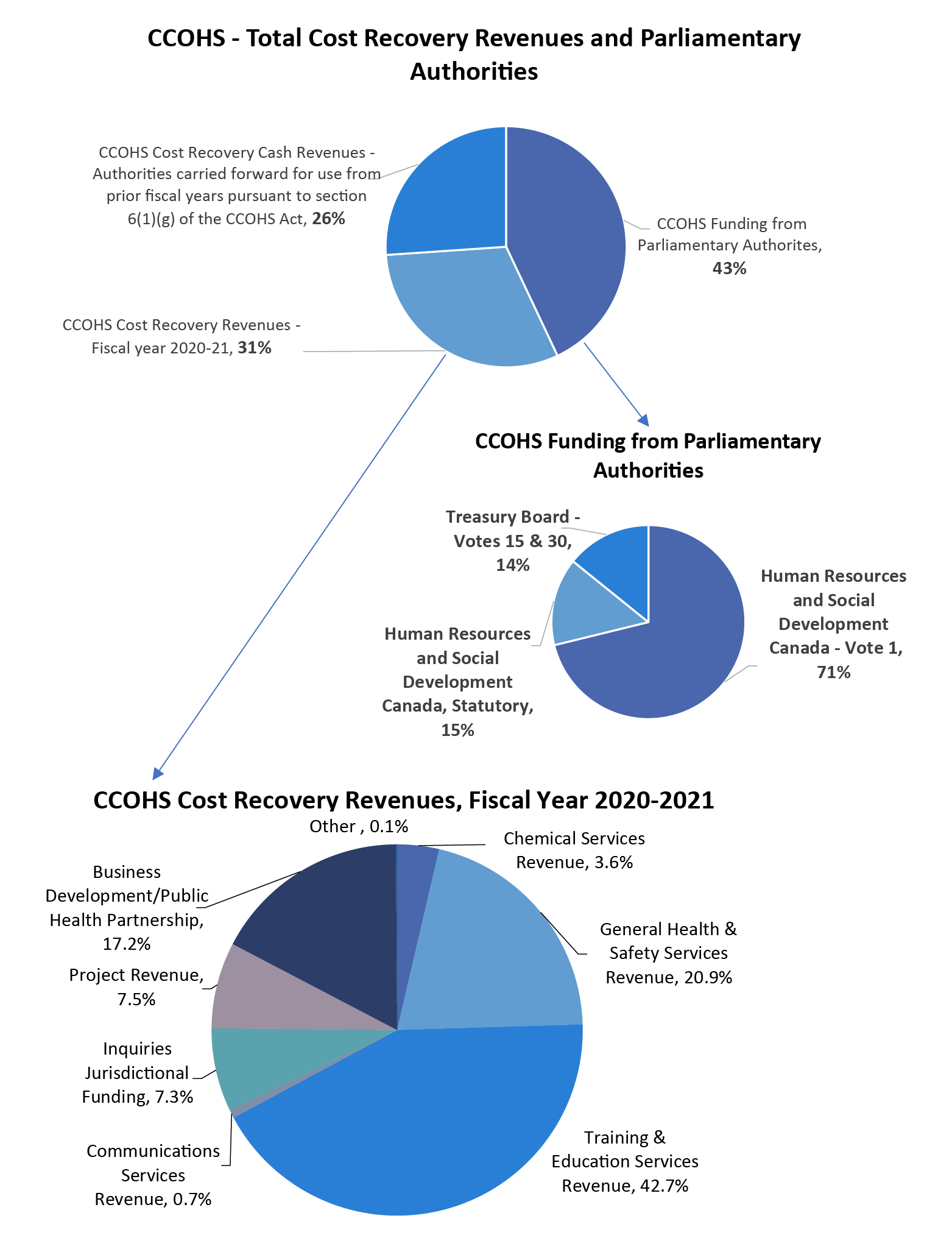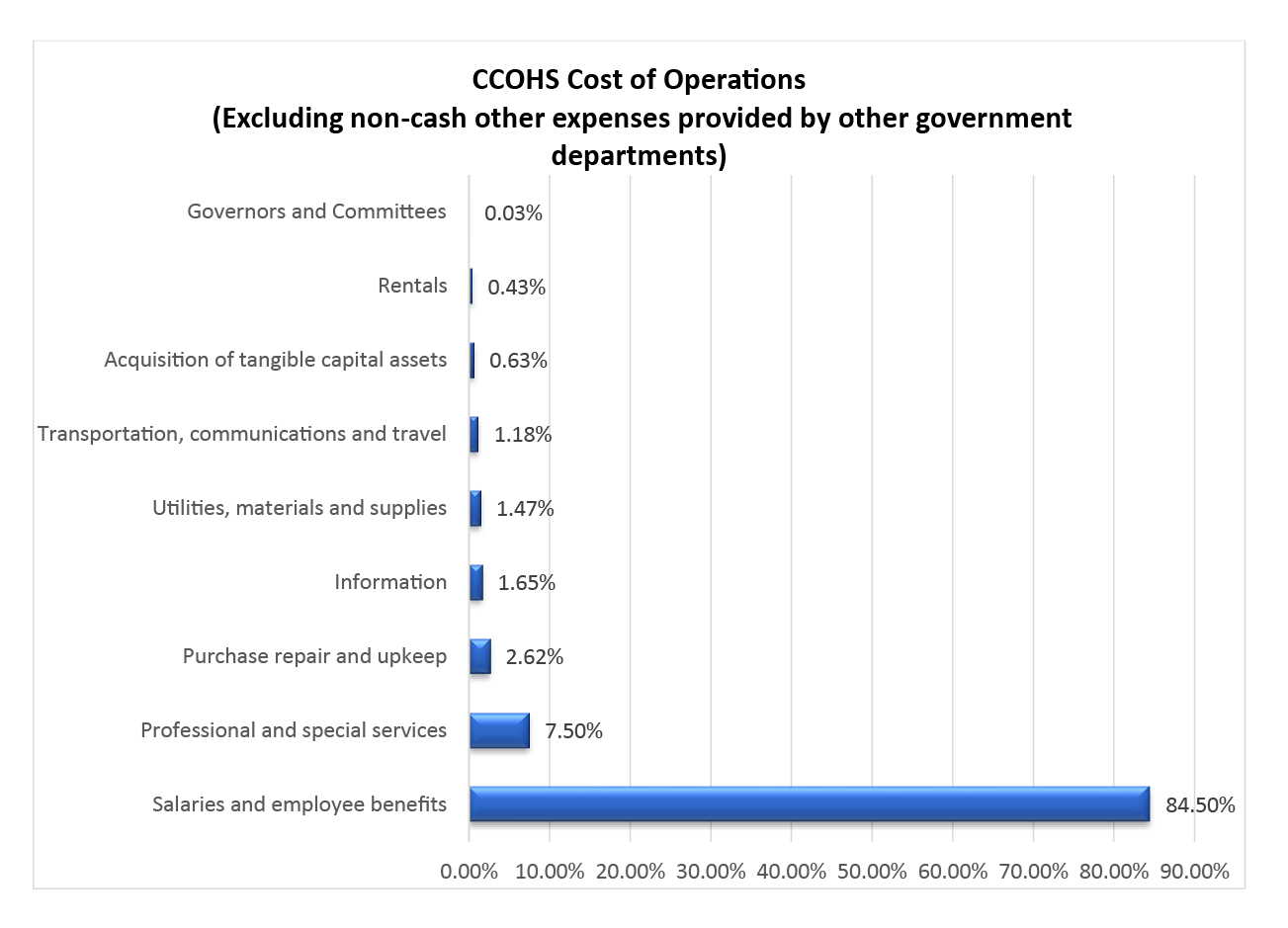Scheduled maintenance - Thursday, July 12 at 5:00 PM EDT
We expect this update to take about an hour. Access to this website will be unavailable during this time.

I am pleased to present the 2020-21 Departmental Results Report for the Canadian Centre for Occupational Health and Safety (CCOHS) as the new Minister of Labour.
CCOHS supports the fundamental rights of all workers in Canada to healthy and safe working environments. CCOHS shares information with employers, workers, and stakeholders across the country to provide a national perspective on current and emerging issues that affect workers and workplaces alike.
This year the COVID-19 pandemic created uncertainty and stress for many and changed how Canadians work. Thousands of frontline and essential workers were called on to serve, putting themselves at risk of infection to ensure we continue to have access to essential goods and services. At the same time, employers have continued to run their businesses while trying to keep their workers and the public protected from the spread of COVID-19.
To support them, CCOHS collaborated with government departments and the Public Health Agency of Canada to develop and provide tools and resources, such as a series of COVID-19 pandemic-related guidance documents, tip sheets, and infographics. CCOHS also developed COVID-19 related business resumption materials through $2.5 million of funding over 2 years provided by the Government of Canada. The funding aimed at helping as many sectors and industries as possible operate safely during the pandemic.
While fighting COVID-19, it is clear that this pandemic has increased the risk of harassment and violence for many people, and that mental health has become an even more prominent concern. To help raise awareness about and promote positive action on these important topics in Canadian workplaces, CCOHS, in collaboration with the Government of Canada, launched a national social media campaign in early 2021.
The need for credible resources related to the health, safety and well-being of workers in Canada has never been greater. As Minister of Labour, my priority remains to ensure that every Canadian lives and works in a safe and secure environment. I look forward to working more with CCOHS to meet the needs of the changing world of work and help make Canada one of the safest and more resilient countries in which to work.
The Honourable Seamus O’Regan Jr. Minister of Labour

I am pleased to present the 2020-2021 Departmental Results Report for the Canadian Centre for Occupational Health and Safety (CCOHS).
This was a year like no other. As the COVID-19 pandemic pressed on, workplaces shut down, remote work became a new reality for many, and essential service workers answered the call to serve. As workplaces struggled to stay functional, CCOHS provided support with guidance and information to help prevent the spread of infection and protect workers. Through partnerships and collaborations with national, regional, and provincial health and safety networks, we were able to put COVID-19 resources for safe work into the hands of employers and workers across Canada. We partnered with the Public Health Agency of Canada and other stakeholders to develop COVID-19 guidance documents and online tool kits, safety tips sheets and new websites (such as Pandemic Info Share). We received funding to develop business resumption materials such as e-courses, infographics and knowledge transfer initiatives to assist as many sectors and industries as possible.
Although COVID-19 was our primary focus, we continued to promote safe work practices in sectors such as agriculture, healthcare and construction, and address topics of concern including harassment and violence, mental health, and occupational disease. With the help of like-minded organizations across Canada, we collaborated and partnered to create e-courses, added content to our topic-specific microsites, created apps, produced informational podcasts, and hosted virtual events to spread prevention messages and good practices to workplaces and workers alike.
CCOHS continued to strengthen its relationships with Indigenous communities to learn about their challenges to better serve them. This year we participated in virtual events hosted by the Nokiiwin Tribal Council to share harassment and violence prevention practices and developed a customized e-course on the transportation of dangerous goods for Indigenous Services Canada.
We continued our partnership with the Government of Canada on a national social marketing campaign,Taking Action Against Violence and Harassment and Mental Health in the Workplace,that addressed the essential elements of a workplace harassment and violence prevention policy and respective procedures. CCOHS developed three new e-courses to help federally regulated work places understand their specific roles and responsibilities in accordance with the Canada Labour Code, Part II, including the Work Place Harassment and Violence Prevention Regulations that came into force on January 1, 2021. Additionally, CCOHS hosts a roster of investigators that have been reviewed by an expert working group to investigate complaints under these regulations.
In this unprecedented year, CCOHS continued to advance its mandate to provide all Canadians with the information, tools, and guidance to make their workplaces both mentally and physically safer and reached more people than ever before. CCOHS will continue to meet whatever challenges lay ahead and serve with purpose.
Anne Tennier, P.Eng. EP President and Chief Executive Officer
$11,705,654
Actual Spending
97.6
Actual FTEs
Outreach: The CCOHS website had over 14.8 million visits (up 12% over the previous year) from 11.4 million unique users (an increase of 15% over the previous year) looking for health and safety information. To help measure the impact of the website, usage surveys were deployed throughout the year and 81% of respondents said they would use the information obtained from the website to make changes in their workplace. The OSH Answers fact sheet service received 13.1 million visits (an increase of 13% over the previous year) from 10.6 million users (up 15% over the previous year). Additionally, the OSH Answers mobile app was downloaded 7,871 times. Through the confidential person-to-person service Safety InfoLine, CCOHS answered 7,699 inquiries (1,375 of which were COVID-19-related).
Partnerships/Collaborations: Partnered with the Public Health Agency of Canada to develop a series of COVID-19 pandemic-related guidance documents and tip sheets for higher-risk occupations, industries, and essential services. More than 60 guidance documents have been published and 33,507 tip sheets having been downloaded; partnered with the Government of Canada on a national social media campaign to raise awareness about harassment and violence prevention, and mental health in Canadian workplaces, resulting in 10.2 million impressions, 274,800 video views and more than 42,500 visits to CCOHS mental health and violence prevention topic pages; partnered with the Occupational Cancer Research Centre (OCRC) to build a database and tool to effectively disseminate and share research and statistics related to occupational disease.
For more information on CCOHS' plans, priorities and results achieved, see the "Results: what we achieved" section of this report.
The goal of the Canadian Centre for Occupational Health and Safety is to provide easy access to credible information on occupational health and safety to help workers in Canada be safe at work, and support employers, labour groups and governments in their efforts to create healthy and safe workplaces. The Canadian Centre for Occupational Health and Safety, as a national institute, provides impartial information through various free and for fee bilingual products and services. Workers and employers in Canada can access a free, confidential service to have their health and safety questions answered personally via telephone, e-mail, person-to-person, fax or mail. In addition, a broad range of online and print resources are offered which support safety and health information needs of workers and workplaces in Canada. Products and services may be financially supported through cost recovery efforts, contributions from the Government of Canada and contributions from other stakeholders.
The Canadian Centre for Occupational Health and Safety collects, evaluates, creates and publishes authoritative information resources on occupational health and safety for the benefit of the working population in Canada. This information is used for education and training, research, development of policy and best practices, improvement of health and safety programs, achieving compliance, and for personal use. When the product or service provided by the Canadian Centre for Occupational Health and Safety is offered to stakeholders such as individuals, groups, and organizations within Canada and abroad with benefits beyond those enjoyed by the general public, the product or service becomes part of the cost-recovery program and a fee is charged.
The Canadian Centre for Occupational Health and Safety promotes and facilitates consultation and cooperation among federal, provincial and territorial jurisdictions and participation by labour, employers and other stakeholders in order to assist in the establishment and maintenance of high standards and occupational health and safety initiatives for the Canadian context. The sharing of resources results in the coordinated and mutually beneficial development of unique programs, products and services. Collaborative projects are usually supported with a combination of financial and non-financial contributions to the programs by partners and stakeholders and result in advancement of the health and safety initiatives.
CCOHS recognizes the importance of the GBA Plus initiative and is committed to ensuring diverse groups of workers in Canada benefit from our GBA Plus policies and programs. CCOHS leadership along with its tripartite Council of Governors ensure that GBA Plus policies and programs are integrated into departmental decision-making processes, by requiring CCOHS to assess the potential implications of products and services produced by CCOHS to support the diverse populations of Canadians.
During fiscal year 2020-21, CCOHS:
Due to the small size of our department, CCOHS does not have the capacity or resources to undertake this initiative.
CCOHS' goals for the 2020-21 year were focused on addressing the three strategic priorities in the occupational sectors and industries, and on the issues identified in the strategic plan: 1) providing services, information and solutions that are easily accessible to employees and employers alike; 2) through facilitation of collaborative initiatives, utilizing knowledge outcomes for the benefit of Canadians and workers throughout Canada; and, 3) providing a National repository of key occupational health and safety knowledge, standards, statistics, and information tools that improves dissemination of occupational health and safety-related information.
Mental Health: CCOHS continues to support organizations in fostering a mentally healthy workplace. Through partnerships with credible organizations and industry leaders across Canada, CCOHS is able to provide an extensive collection of mental health resources including e-courses, fact sheets, podcasts, websites, web apps and tools.
Harassment and Violence: To help organizations work towards creating environments that are free from harassment and violence, CCOHS continued to develop resources such as e-courses, podcasts and infographics focused on preventative measures. Additional initiatives included:
Occupational Disease: CCOHS focused on producing resources to help workplaces safely stay operational during the COVID-19 pandemic, as well as sharing resources to help educate Canadians about occupational cancers and other occupational diseases.
Impairment in the Workplace: CCOHS continued to stay at the forefront of the workplace impairment issue, providing practical advice and guidance through various informational formats and materials.
| Departmental Results | Performance Indicators | Target | Date toachieve target | 2018-19 Actual results | 2019-20Actual results | 2020-21Actual results |
|---|---|---|---|---|---|---|
| Canadians and workers in Canada can easily access the Canadian Centre for Occupational Health and Safety's occupational health and safety information and services. | Number of learning activities and opportunities on emerging occupational health and safety issues and for priority sectors. | Between 100 and 140 learning events on emerging occupational health and safety issues and for priority sectors. | March 2021 | * Not available | * Not available | 125 |
| Number of social media impressions on emerging occupational health and safety issues and for priority sectors, where CCOHS is referenced as the source. | Up to 2,500,000 social media impressions | March 2021 | 2,246,613 | 2,474,648 | 2,925,959 | |
| Percentage of users of CCOHS' website who indicated that information was easy to access. | Between 65% and 75% | March 2021 | 84.7% | 85% | 86% | |
| Provide Canadians and workers in Canada with a national repository of key occupational health and safety knowledge, standards, statistics, and information tools that improves dissemination of occupational health and safety related information. | Number of collections of occupational health and safety related records made available to Canadians and workers in Canada through repository tools. | Between 1 to 3 new collections of records per year | March 2021 | *Not available | *Not available | 1 |
| Number of new tools made available to workers in Canada which address emerging occupational health and safety issues and for priority sectors. | Between 20 and 30 new tools per year | March 2021 | *Not available | *Not available | 79 | |
| Number of times users accessed CCOHS' free online repository of occupational health and safety information or used its person-to-person support services. | Between 1,900,000 to 2,300,000 times | March 2021 | *Not available | *Not available | **4,000,000 | |
| Through the facilitation of collaborative initiatives with labour, employers and/or government on emerging occupational health and safety issues and for priority sectors, knowledge outcomes are utilized for the benefit of Canadians and workers throughout Canada. | Number of new collaborative initiatives with a tripartite perspective on emerging occupational health and safety issues and for priority sectors, where knowledge outcomes are serviceable across Canada. | Up to 6 new initiatives per year | March 2021 | *Not available | *Not available | 5 |
* Beginning in fiscal year 2020-21 CCOHS implemented new departmental results / indicators to align with the expansion of CCOHS' strategic initiatives as a national leader on emerging occupational health and safety issues.
| 2020-21 Main Estimates | 2020-21Planned Spending | 2020-21Total authoritiesavailable for use | 2020-21 Actual spending(authorities used) |
2020-21
Difference(Actual
spending minus Planned spending) |
|---|---|---|---|---|
| 7,129,798 | 7,129,798 | 13,473,043 | 7,577,114 | 447,316 |
| 2020-21Planned full-time equivalents | 2020-21Actual full-time equivalents | 2020-21 Difference (Actual full-time equivalents minus Planned full-time equivalents) |
|---|---|---|
| 71 | 70.8 | (0.2) |
Financial, human resources and performance information for CCOHS' Program Inventory is available in GC InfoBase.
Internal Services are those groups of related activities and resources that the federal government considers to be services in support of programs and/or required to meet corporate obligations of an organization. Internal Services refers to the activities and resources of the 10 distinct service categories that support Program delivery in the organization, regardless of the Internal Services delivery model in a department. The 10 service categories are:
| 2020-21 Main Estimates | 2020-21Planned Spending | 2020-21Total authoritiesavailable for use | 2020-21 Actual spending(authorities used) | 2020-21 Difference (Actual spending minus Plannedspending) |
|---|---|---|---|---|
| 4,187,342 | 4,187,342 | 7,435,697 | 4,128,539 | (58,803) |
| 2020-21Planned full-time equivalents | 2020-21Actual full-time equivalents | 2020-21 Difference (Actual full-time equivalents minus Planned full-time equivalents) |
|---|---|---|
| 24 | 26.8 | 2.8 |
As CCOHS was called upon to support the government response to the COVID-19 pandemic, additional health and safety specialists and supporting staff were required to support public health and business resumption activities.
The following graph presents planned (voted and statutory spending) over time.

The total spending reported in 2018-19 through 2021-22 includes Parliamentary appropriations and revenue sources including main estimates, recoveries and the use of cash respendable revenues pursuant to section 6(1)(g) of the Canadian Centre for Occupational Health and Safety Act.
Fiscals 2022-23 and 2023-24 planned spending authorities represents authorities approved in the 2021-22 Main Estimates and do not represent the use of CCOHS' respendable revenues.
| Core responsibilities and Internal Services | 2020-21 Main Estimates | 2020-21 Planned spending | 2021-22 Planned spending | 2022-23 Planned spending | 2020-21Total authorities available for use | 2018-19 Actual spending (authorities used) | 2019-20 Actual spending (authorities used) | 2020-21 Actual spending (authorities used) |
|---|---|---|---|---|---|---|---|---|
| National Occupational Health and Safety Resource | 7,129,798 | 7,129,798 | 9,336,865 | 6,429,591 | 13,473,043 | 6,653,617 | 6,953,799 | 7,577,114 |
| Internal Services | 4,187,342 | 4,187,342 | 5,483,556 | 3,776,109 | 7,435,697 | 3,906,430 | 4,227,191 | 4,128,539 |
| Total | 11,317,140 | 11,317,140 | 14,820,421 | 10,205,700 | 20,908,740 | 10,560,047 | 11,180,990 | 11,705,653 |
The 2020-21 total authorities available for use shown in the table above represents the planned Parliamentary appropriations and revenue sources including the main estimates, supplementary estimates, recoveries and the use of cash respendable revenues pursuant to section 6(1)(g) of the Canadian Centre for Occupational Health and Safety Act.
Actual spending for fiscal 2020-21 was 3.4% above plan and 4.7% above the prior year. Additional spend was required to support the whole-of-government response to the COVID-19 pandemic, as well as supporting the move to a remote work environment.
| Core responsibilitiesand Internal Services | 2018-19 Actual full-time equivalents | 2019-20Actual full-time equivalents | 2020-21Planned full-time equivalents | 2020-21Actual full-time equivalents | 2021–22Planned full-time equivalents | 2022-23Planned full-time equivalents |
|---|---|---|---|---|---|---|
| National Occupational Health and Safety Resource | 63 | 62.3 | 71 | 70.8 | 86 | 71 |
| Internal Services | 18 | 21 | 24 | 26.8 | 29 | 24 |
| Total | 81 | 83.3 | 95 | 97.6 | 115 | 95 |
For information on CCOHS's organizational voted and statutory expenditures, consult the Public Accounts of Canada 2020-2021.
Information on the alignment of CCOHS's spending with the Government of Canada's spending and activities is available in GC InfoBase.
CCOHS's financial statements (unaudited) for the year ended March 31, 2021, are available on the departmental website.
| Financial information | 2020-21Planned results | 2020-21Actual results | 2019-20Actual results | Difference (2020-21 Actual results minus 2020-21 Planned results) | Difference (2020-21 Actual results minus 2019-20 Actual results) |
|---|---|---|---|---|---|
| Total expenses | 12,525,223 | 13,177,926 | 12,201,850 | 652,703 | 976,076 |
| Total revenues | 5,626,107 | 6,442,648 | 5,951,904 | 816,541 | 490,744 |
| Net cost of operations before government funding and transfers * | 6,899,115 | 6,735,278 | 6,249,946 | (163,838) | 485,332 |
* Net cost of operations includes the spending of available cash revenues pursuant to section 6(1)(g) of the CCOHS Act.
Fiscal year 2020-21 saw an increase in the net cost of operations over the prior year (+7.8%). An increase of 4.5% was expected yet the year’s activities were far from what was planned. In support of the government response to the COVID-19 pandemic, unexpected projects resulted in both increasing cost recovery revenues and expenditures.
Cost recovery revenues were projected to decrease due to the completion of several projects. New emerging strategic programs and priorities were also expected to be transitioned, with an overall reduction in revenues of 4.6%. As expected, there was a reduction in revenues related to the completed projects. However, the unexpected impact of the COVID-19 pandemic led CCOHS to see an overall 8.2% increase in revenues. This increase primarily stemmed from the partnership with the Public Health Agency of Canada (PHAC).
Operating expenses were higher than planned given the unexpected impact of the COVID-19 pandemic. CCOHS had increased spending to support the government response to the COVID-19 pandemic. Additional health and safety specialists and other supporting team members were hired. These new employees were essential to create the key public health and business resumption tools needed to support the government response to the pandemic. In addition, CCOHS quickly transitioned and supported workers in a remote work environment. This shift resulted in increased spending on computing devices and technological support.
| Financial Information | 2020-21 | 2019-20 | Difference (2020-21 minus 2019-20) |
|---|---|---|---|
| Total net liabilities | 3,900,017 | 3,824,938 | 75,079 |
| Total net financial assets | 2,209,184 | 2,309,909 | (100,725) |
| Departmental net debt | (1,690,833) | (1,515,029) | (175,804) |
| Total non-financial assets | 380,881 | 423,798 | (42,917) |
| Departmental net financial position | (1,309,952) | (1,091,231) | (218,721) |
Total CCOHS liabilities of $3.9 million include: $1.781 million in accounts payable and accrued liabilities payable; $1.110 million in deferred cost recovery revenues and $896 thousand in deferred employee compensation and benefits. The increase of $75 thousand is related to a $98 thousand increase in deferred cost recovery revenues; an increase of $230 thousand in deferred vacation pay and compensated leave offset partially by a $183 thousand reduction in deferred employee severance benefits and a $70 thousand reduction in accounts payable and accrued liabilities.
Total CCOHS non-financial assets of $381 thousand consist of $238 thousand of tangible capital assets.
The decrease of $219 thousand in departmental net financial position, which is the difference between the total non-financial assets and the departmental net debt, is mainly attributable to the increase in vacation pay and deferred revenues.


Raison d'être, mandate and role: who we are and what we do is available on the Canadian Centre for Occupational Health and Safety's website.
Canadian Centre for Occupational Health and Safety (CCOHS) operates under the legislative authority of the Canadian Centre for Occupational Health and Safety Act (S.C., 1977-78, c. 29) which was passed by unanimous vote in the Canadian Parliament in 1978. CCOHS' mandate is to promote health and safety in the workplace and to enhance the physical and mental health of workers in Canada. CCOHS functions as an independent departmental corporation under Schedule II of the Financial Administration Act and is accountable to Parliament through the Minister of Labour.
As Canada's national occupational health and safety resource, CCOHS is dedicated to the advancement of workplace health and safety. We do this by providing information and knowledge transfer services; training and education; cost-effective tools for improving occupational health and safety performance; management systems services supporting health and safety programs; injury and illness prevention initiatives and promoting the total well-being - physical, psychosocial and mental health - of working people.
CCOHS is a recognized leader in providing effective programs, products and services, which are based on the centre's core knowledge, collection of occupational health and safety information, and application of information management technologies.
CCOHS has a broad range of collaborative arrangements with many national and international health and safety organizations. These include the World Health Organization (WHO), International Labour Organization (ILO), North American Occupational Safety and Health Week (NAOSH), European Agency for Safety and Health at Work and Health Canada and the Mental Health Commission of Canada. Further information on our partnerships is available on our website and in our annual report.
Collaborative projects serve many purposes at CCOHS. They are opportunities to enhance our occupational health and safety information resources, collaborate with partners worldwide to access and share global perspectives. This collaboration among nations serves to promote the sharing of information and knowledge for social and economic programs relating to health and safety, reduce injuries and illness, and improve conditions for workers. They also contribute to Canada's leadership role in the world and bring the wealth of global occupational health and safety information for use by CCOHS to improve the health and safety of working people in Canada.
Information on the operating context is available on the Canadian Centre for Occupational Health and Safety's website.
CCOHS is governed by a tripartite council representing governments (federal, provincial and territorial), employers, and labour organizations. The Council of Governors (Council) assists in overseeing a policy framework for a trustworthy and complete occupational health and safety service and ensures that the information CCOHS disseminates is unbiased. CCOHS' Council members are directly involved in the governance and strategic planning for the organization. Council also assists with reviews of programs and services to help ensure that CCOHS' information is impartial and relevant. Along with federal government support, CCOHS' inquiries service is supported and partially funded from contributions provided by provincial and territorial governments.
The Canadian Centre for Occupational Health and Safety's Departmental Results Framework and Program Inventory of record for 2020-21 are shown below.
Departmental Results Framework
Core Responsibility: National Occupational Health and Safety Resource
Departmental Results: Canadians and workers in Canada can easily access the Canadian Centre for Occupational Health and Safety’s occupational health and safety information and services.
Departmental Results: Provide Canadians and workers in Canada with a National repository of key occupational health and safety knowledge, standards, statistics, and information tools that improves dissemination of occupational health and safety related information.
Departmental Results: Through the facilitation of collaborative initiatives with labour, employers and/or government on emerging occupational health and safety issues and for priority sectors, knowledge outcomes are utilized for the benefit of Canadians and workers throughout Canada.
Program Inventory
Financial, human resources and performance information for the Canadian Centre for Occupational Health and Safety's Program Inventory is available in GCInfoBase
The following supplementary information tables are available on the Canadian Centre for Occupational Health and Safety's website.
The tax system can be used to achieve public policy objectives through the application of special measures such as low tax rates, exemptions, deductions, deferrals and credits. The Department of Finance Canada publishes cost estimates and projections for these measures each year in the Report on Federal Tax Expenditures. This report also provides detailed background information on tax expenditures, including descriptions, objectives, historical information and references to related federal spending programs as well as evaluations and GBA Plus of tax expenditures.
For Departmental Plans and Departmental Results Reports, planned spending refers to those amounts presented in Main Estimates.
A department is expected to be aware of the authorities that it has sought and received. The determination of planned spending is a departmental responsibility, and departments must be able to defend the expenditure and accrual numbers presented in their Departmental Plans and Departmental Results Reports.